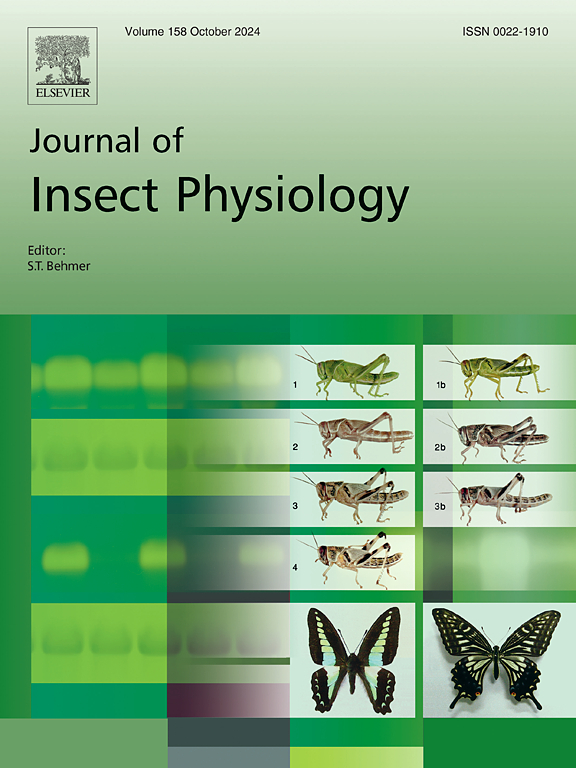Autophagy in the retina affects photoreceptor synaptic plasticity and behavior
IF 2.3
2区 农林科学
Q1 ENTOMOLOGY
引用次数: 0
Abstract
The visual system is a sensory system which is sensitive to light and detects photic stimuli. It plays many important functions, such as vision, circadian clock entrainment and regulation of sleep-wake behavior. The interconnection between the visual system and clock network is precisely regulated. The outer layer of the visual system called the retina, is composed of opsin-based photoreceptors that, in addition to visual information, provide photic information for the circadian clock, which in turn, regulates daily rhythms, such as activity and sleep patterns. The retina houses its own circadian oscillators (belonging to peripheral oscillators), however, they are also controlled by the main clock (pacemaker). Photoreceptor cells show many clock and light-dependent rhythms, such as the rhythms in synaptic plasticity or rhodopsin turnover, but their precise regulation is still not completely understood. In this study, we provided evidence that one of the mechanisms involved in the regulation of retinal rhythms is autophagy. We showed that autophagy is rhythmic in photoreceptors, with a specific daily pattern of autophagosome levels in different cells. Moreover, our data suggest that rhythmic autophagy-dependent degradation of the presynaptic protein Bruchpilot or photosensitive rhodopsin is involved in the regulation of daily rhythms observed in the retina. In effect, autophagy disruption in the photoreceptors, which affects photic signal transmission to the main clock neurons, causes changes in sleep level and pattern.

视网膜的自噬影响感光细胞突触的可塑性和行为。
视觉系统是一种感觉系统,它对光很敏感,能探测到光刺激。它具有许多重要的功能,如视觉、生物钟引导和睡眠-觉醒行为的调节。视觉系统和时钟网络之间的连接是精确调节的。视觉系统的外层称为视网膜,由视蛋白为基础的光感受器组成,除了视觉信息外,它还为昼夜节律钟提供光信息,昼夜节律钟反过来调节日常节律,如活动和睡眠模式。视网膜拥有自己的昼夜节律振荡器(属于外围振荡器),然而,它们也由主时钟(起搏器)控制。光感受器细胞表现出许多时钟和光依赖的节律,如突触可塑性或视紫红质更新的节律,但它们的精确调控尚不完全清楚。在这项研究中,我们提供了证据,其中一个机制参与视网膜节律的调节是自噬。我们发现自噬在光感受器中具有节律性,在不同细胞中具有特定的自噬体水平的每日模式。此外,我们的数据表明突触前蛋白Bruchpilot或光敏视紫质的节律性自噬依赖性降解参与了视网膜中观察到的日常节律调节。实际上,自噬破坏光感受器,影响光信号传递到主要时钟神经元,导致睡眠水平和模式的变化。
本文章由计算机程序翻译,如有差异,请以英文原文为准。
求助全文
约1分钟内获得全文
求助全文
来源期刊

Journal of insect physiology
生物-昆虫学
CiteScore
4.50
自引率
4.50%
发文量
77
审稿时长
57 days
期刊介绍:
All aspects of insect physiology are published in this journal which will also accept papers on the physiology of other arthropods, if the referees consider the work to be of general interest. The coverage includes endocrinology (in relation to moulting, reproduction and metabolism), pheromones, neurobiology (cellular, integrative and developmental), physiological pharmacology, nutrition (food selection, digestion and absorption), homeostasis, excretion, reproduction and behaviour. Papers covering functional genomics and molecular approaches to physiological problems will also be included. Communications on structure and applied entomology can be published if the subject matter has an explicit bearing on the physiology of arthropods. Review articles and novel method papers are also welcomed.
 求助内容:
求助内容: 应助结果提醒方式:
应助结果提醒方式:


